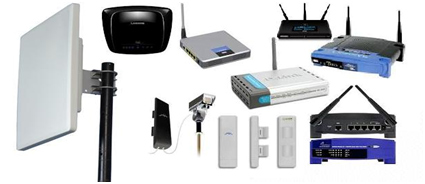

Wireless Routers

Before deciding on buying a specific router ask yourself if you want computers to be able to connect wired or wirelessly to your network.
A wireless router is a network device that enables you connects several computers to the Internet without using cables, rather by using wireless access points, or WLAN. Some of the reason we go wireless networking include freedom and affordability. But you need to keep other factors in mind.
Look out for notable brands like Cisco, Net Gear, Linksys and D-link. These are most popular brands built with rugged technologies.
Bandwidths and performance should be another factor to check for. A wireless standard defines the speed for interconnectivity or data transmission by a particular router. E.g. 802.11a, 802.11g, 802.11n etc
What are the Features of a Wireless Network?

Whether you are setting up a wireless network at home or in the office, there are many features available to you with the network installation. From sharing information directly to connecting to the same Internet source, wireless networks may using multiple computers in the same location far easier than having each computer run individually.
To start, when using a wireless network each computer is able to access all the same hardware, such as printers and scanners. This saves you a good deal of money over purchasing equipment for each and every computer. Once the hardware is connected to the network hub via wireless hook-up and the necessary drivers are installed on all the computers, any computer is capable of sending print requests directly to the desired hardware.

Sharing data is far easier with a wireless network once a network drive is installed. The network drive can be an external hard drive hooked up to the network hub. Once set up all computers have access to storage space on the drive. This allows you to save important documents onto the drive form one computer, then access the information on a second computer.
With a wireless network, all computers in the home or office can access the Internet, without a wired connection. The password is the same for connecting to the network, and it saves you the time of setting up a wired Ethernet hook up and the cost associated with purchasing all the cables and other hardware necessary for setting up the equipment. It also makes troubleshooting an Internet connection far easier, as there are less cables and wires you need to look over before determining what the problem is. Simply saving time is often well worth the price of admission, as the wireless network proves to be a valuable asset.
Wired / Structured network:
Networking provides the ability to monitor and control operations and machinery remotely. It provides the ability to incorporate device diagnostics and alarm reporting for operations, equipment, and devices. By using networking, troubleshooting and corrective actions can be accomplished remotely. These capabilities can enhance safety, increase productivity, and reduce the number of engineers, equipment operators, and maintenance personnel needed.

Networks of the Future
Imagine a company where as soon as an employee enters the elevator a surveillance camera detects his face or photo ID and immediately connects with the authorised desktop to inform about his arrival so that the desktop turns on automatically.
In another context, imagine that the vice-president of sales can use his smartphone to access data by logging on to the corporate network securely and his technical team can stop worrying that accessing business-critical applications along with personal information will severely tax bandwidth.
While the scenarios appear futuristic, it is true that networks can be designed to handle a lot more than what they do today, be it determining what employees are doing or helping business leaders make better decisions.
Organisations with such capabilities on their network will be much better equipped to handle any customer/employee queries in real time and provide them with a satisfactory experience. Such intelligent networks need unification of wired and wireless access to support the proliferation of devices and ubiquitous mobility.

GenNext network
A next-generation network is a strategically developed network that is optimised for today’s requirements and is also customised to accommodate future technology disruptions and provide investment protection. It supports trends around mobility, cloud computing and the changing threat landscape and transforms the network into a service-delivery mechanism that enables IT organisations to not only say 'yes' to strategic business efforts, but also roll out these services broadly and deliver value back to the business. A next-generation network provides ease of use and management capabilities.
An enterprise next-generation network is a unified network consisting of wired and wireless, virtual private network (VPN), building and energy control. It integrates security capabilities from the premise to the cloud, leads to less administrative overhead and fewer security gaps. A next generation network is application and endpoint aware and adjusts to the application being delivered and the endpoint device on which it appears.

The future
In the future the role of network administrators' will change, because rather than just focusing on how applications and devices connect to the network, they will have to look at the performance of the application on the network, make adjustments to packet transfer rates and integrate virtualisation into the network operating system.
Clearly, the network of the future will be incredibly flexible and intelligent. Services will be consumed dynamically, and this will be made possible by and is completely dependent on, dynamic and flexible network services.